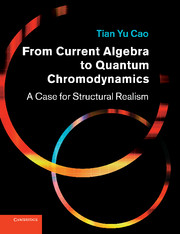Book contents
- Frontmatter
- Contents
- Preface
- 1 Introduction
- 2 The rise of current algebra
- 3 Sum rules
- 4 Saturation and closure
- 5 Scaling
- 6 Theorizations of scaling
- 7 The advent of QCD
- 8 Early justifications and explorations
- 9 Structural realism and the construction of QCD
- 10 Structural realism and the construction of the CA–QCD narrative
- References
- Author index
- Subject index
10 - Structural realism and the construction of the CA–QCD narrative
Published online by Cambridge University Press: 06 December 2010
- Frontmatter
- Contents
- Preface
- 1 Introduction
- 2 The rise of current algebra
- 3 Sum rules
- 4 Saturation and closure
- 5 Scaling
- 6 Theorizations of scaling
- 7 The advent of QCD
- 8 Early justifications and explorations
- 9 Structural realism and the construction of QCD
- 10 Structural realism and the construction of the CA–QCD narrative
- References
- Author index
- Subject index
Summary
Writing a conceptual history of QCD is exciting. The materials of the project are not natural phenomena of nuclear forces, which are inherently meaningless occurrences; not quasi-independent abstract ideas, whose causal effectiveness in moving history forward only idealist historians would believe; but human activities, in which meaning was radically changing with the change of perspective, and whose long-term significance for physics, metaphysics, and culture in general is to be discerned and interpreted by historians of science.
Historians' interpretations, however, are conditioned and constrained by the wide cultural milieu. Broadly speaking, at the center of contemporary cultural debate on issues related to science, such as objectivity and progress in science or the nature of scientific knowledge and its historical changes, sit two closely related questions. First, can science provide us with objective knowledge of the world? Second, is the evolution of science progressive in nature in the sense that it involves the accumulation of objective knowledge? The old wisdom that science aims at discovering truths is seriously challenged by such prominent commentators as Richard Lewontin and Arthur Fine. According to Lewontin (1998), taking science as a reality-driven enterprise has missed the essential point of science as a social activity, namely, its ambiguity and complexity caused by the socio-historical setting that has put severe constraints on the thought and action of scientists. In his Presidential Address at the Central Division of the American Philosophical Association, Fine (1998) has skillfully dissolved the notion of objectivity and reduced it to a democratic procedure, which may contribute to enhance our trust in the product of scientific endeavor, but has nothing to do with the objective knowledge the product may provide.
- Type
- Chapter
- Information
- From Current Algebra to Quantum ChromodynamicsA Case for Structural Realism, pp. 242 - 274Publisher: Cambridge University PressPrint publication year: 2010



